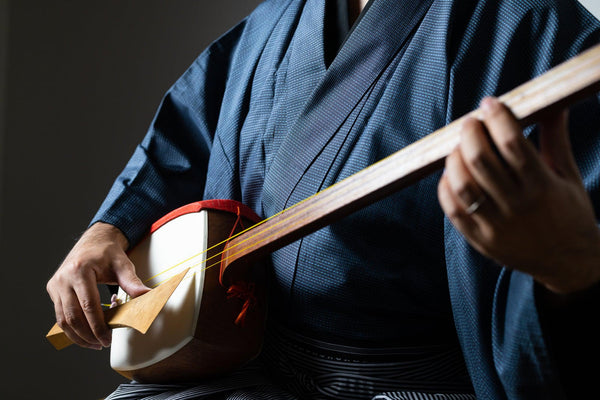
Jump to:
From its roots in shamanistic rituals in the prehistoric period to the energetic and catchy melodies of J-Pop in the modern era, music has always played an important role in Japanese culture. This musical history has been shaped, in large part, by the diverse range of musical instruments developed in Japan.
In this post, we shall discuss the various types of Japanese musical instruments, dividing them into the three main categories of chordophones (string), aerophones (wind), and membranophones/idiophones (percussion).
I will start, however, by providing a brief overview of the history of music in Japan, before looking at the musical instruments that have played a prominent role in each era.
The History Of Japanese Music

Although it is not entirely clear when music was first played in Japan, archaeological findings going back to prehistoric times suggest that, even then, music and dance played an important role in shamanistic rituals, that is rituals that involve communication with the spirit world for the purpose of achieving healing, etc. Some of the earliest forms of musical instruments may have included flutes made from animal bones, drums from hollowed-out logs, and conch shells.
With the introduction of Buddhism to Japan around the 7th century, the focus turned to music for entertaining royalty in the court as well as Buddhist chanting. Music also played an important role in Shinto rituals and ceremonies.
Moving into the Kamakura and Muromachi periods from the 12th to the 16th century, music was highly influenced by samurai culture such as Noh theater, which combines music and dance, as well as drama.
With the dawning of the Edo era, music continued to be influenced by theater in the form of Kabuki and Bunraku, as well as folk music (or Minyo). This music consisted of traditional songs that were sung while laboring, at festivals, and at communal gatherings, and were passed down from generation to generation. Many such songs have lasted until the present day and are an important part of Japan’s cultural heritage.
The Meiji restoration brought Western influences into Japanese music, including instruments such as the piano and violin, and marching bands. There was also a blending of traditional Japanese music and Western styles. Contemporary music then appeared after World War II, heavily influenced by the U.S. occupation, and Japanese music embraced genres such as rock and pop, with traditional music still remaining integral to cultural festivals, performing arts, and ceremonies.
Types Of Japanese Instruments
Here, we shall classify Japanese instruments into chordophones, aerophones, and membranophones/idiophones. Given that these are not common words in most people’s vocabularies, we should probably start with some definitions.
A chordophone is a type of musical instrument in which sound is primarily produced by the vibration of strings stretched between two points. A guitar would be a well-known example of such an instrument.
Aerophones, commonly known as wind instruments, are a class of instruments where the sound is produced primarily by the vibrations of air through the instrument, such as a flute.
Membranophones and idiophones would both be examples of what are commonly known as percussion instruments but differ in an important way. In the case of a membranophone, the sound is produced by the vibration of a stretched membrane within the instrument, such as the skin on a drum. With an idiophone, the vibration is produced by the body of the instrument itself. A xylophone would be a good example of an idiophone.
We will now look at the Japanese instruments that fall within each category.
Chordophones

When it comes to chordophones, or stringed instruments, perhaps the most famous are the Koto and the Shamisen.
The Koto is a 13-stringed instrument introduced to Japan from China around the 7th century and was initially prominent in court music. Although its popularity declined with the popularization of Western music during the Meiji restoration, it remains a vital part of Japanese cultural heritage.
The Shamisen is a banjo-like three-stringed instrument with a long neck and no frets. Originally introduced to Japan around the 16th century, it became popular in Kabuki theater and geisha during the Edo period. The body of the Shamisen is traditionally covered with a cat or body skin
Another chordophone that you may be familiar with is the Biwa. This is a traditional Japanese lute with four or five strings and a pear-shaped body. Its use dates back to the 8th entury when it was used in court music. Later it became associated with storytelling and narrative music, as its deep resonant sounds convey a dramatic quality.
Some lesser known chordophones are the Sanshin, a three-stringed lute originating from Okinawa played with a plectrum, the Ichigenkin, also played with a plectrum, but consisting of a single string stretched over a long, narrow body, the Yamatogoto, a rarer six or seven-stringed version of the Koto that was also played in court music, and the Kokyu, similar to a fiddle, and the only Japanese musical instrument that is played with a bow.
Aerophones

The most well-known aerophones on the other hand are perhaps the Shakuhachi and the Sho, which are both types of flute, but differ in important ways, both from each other, and from Western flutes in general. The Shakuhachi is a bamboo flute that has five finger holes, four in the front and one in the back, and is blown at the end. In this sense, it is closer to a recorder than a flute.
The Sho, however, traditionally used in Noh and Kabuki theater, is more like a mouth organ and is usually constructed of pipes with reeds in them. This enables it to play chords and produces a bright ethereal sound.
Of the less common aerophones, the Nohkan, Ryuteki, Shinobue, and Komabue share the similarity of being side-blown flutes made of bamboo. Of these, however, the Nohkan is specific to Noh theater, while the Ryuteki and Komabue are used in gakaku, a traditional form of Japanese court performed for over a millennium, that also encompasses East-Asian musical influences from China and Korea. The Shinobue, on the other hand, is traditionally used in the Minyo folk music, Japanese festivals, and Kabuki theater.
In a different category of aerophone to these is the Hichiriki, a double reed instrument somewhat similar to the Western oboe. It is held vertically and the reed is inserted into the mouthpiece. It is also used in gagaku court music.
Membranophones

If you've ever attended a Japanese festival rooted in shrine traditions, you've likely experienced the commanding resonance of the Taiko drum, including its larger counterpart, the Odaiko. Introduced from China in the 7th century, these drums have held a significant place in Japanese music ever since. Today, they're not only integral to festivals but also feature prominently in contemporary music and stage performances.
A lesser known membranophone is the Tsuzumi , which is an hour-glass shaped drum with one large and one small head traditionally used in Noh theater and Kabuki, where its distinctive piercing sound adds dramatic value to the production.
The Okedo, on the other hand, is a barrel-shaped drum used in folk music, Kabuki and Bunraku theater, Taiko ensembles and may also be used for its unique timbre to provide originality to contemporary music.
Idiophones

Some examples of idiophones are the Atarigane, the Kagura Suzu, the and the Mokugyo.
The Atarigane is a small hand-held gong that makes clear metallic sounds that add accents to traditional Japanese music and dance. It is also popularly used in folk music and religious ceremonies. The Mokugyo dates back to the Edo period, and, also known as a “wooden fish” (as it is often carved in the shape of a fish), it is typically used in Buddhist rituals and ceremonies that involve chanting and sutra recitations, making a distinct, resonant sound when struck with a mallet. Last, but by no means least, the Kagura Suzu. Have you ever seen what looks like a set of bells mounted on a handle held by shrine maidens (Miko) during Shinto rituals? These are Kagura Suzu and are particularly prominent during Kagura performances, which are Shinto rituals combining dance, music, and theatrical elements. Their bright and jingling sound enhance the ceremonial atmosphere.
The Timeless Appeal Of Japanese Musical Instruments
Japanese musical instruments are deeply rooted in the nation's rich cultural heritage and their influence still resonates in both traditional and contemporary Japanese music. The chordophones like the Koto and Shamisen, aerophones such as the Shakuhachi and Sho, and membranophones like the Taiko drums have not only provided musical accompaniment to various cultural ceremonies and theater but also adapted to new musical genres and influences.
Musical instruments also reflect the Japanese ideal of making good things that last, and the craftsmanship and artistry involved in creating these instruments go beyond the production of music itself, and they are themselves works of art, reflecting the aesthetics and values of Japanese society. The enduring popularity of these instruments in festivals, theater, and daily life underscores their significance and the ongoing effort to keep the spirit of Japanese music alive for future generations.
Do you play any Japanese musical instruments, or do you particularly enjoy listening to any instrument or type of Japanese music? Please let us know in the comments.


0 comments